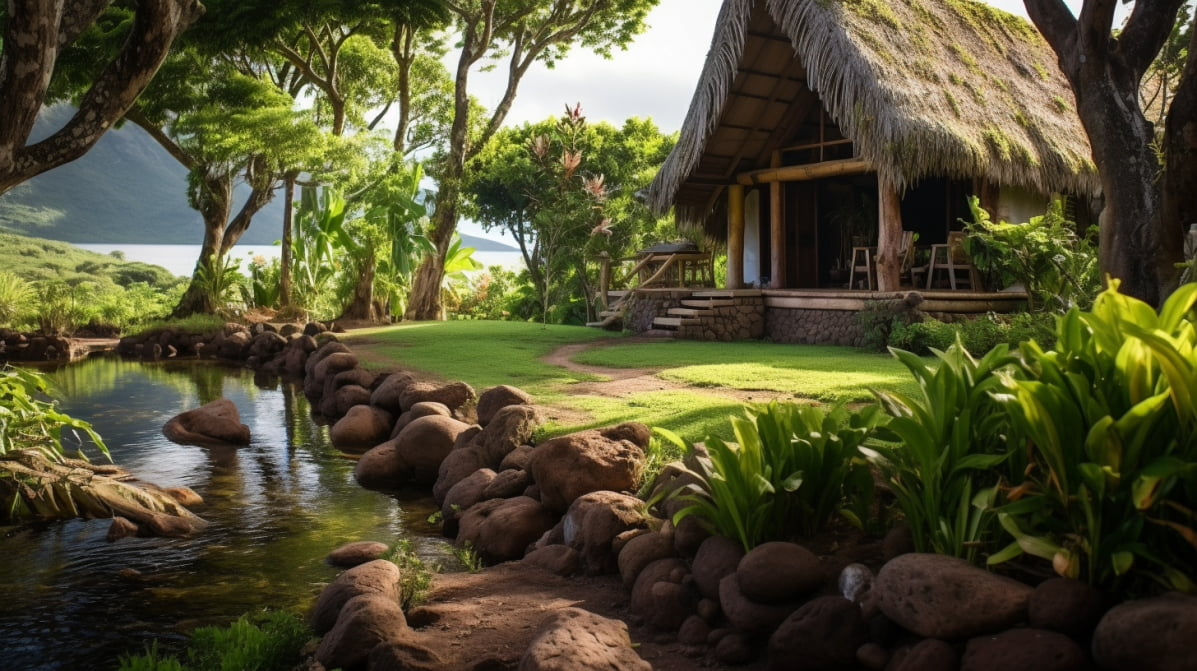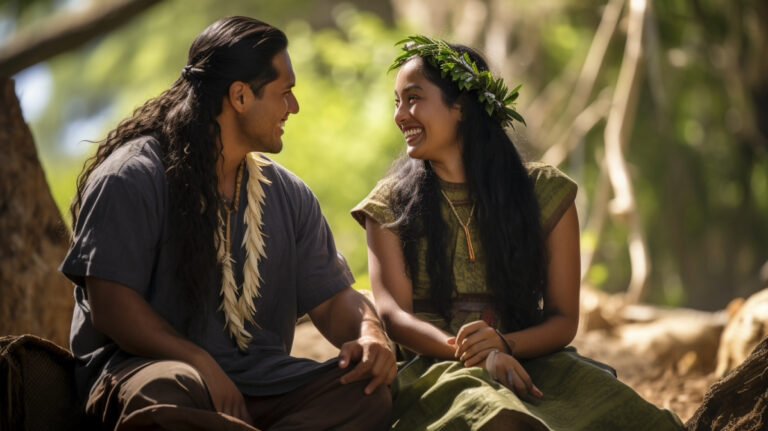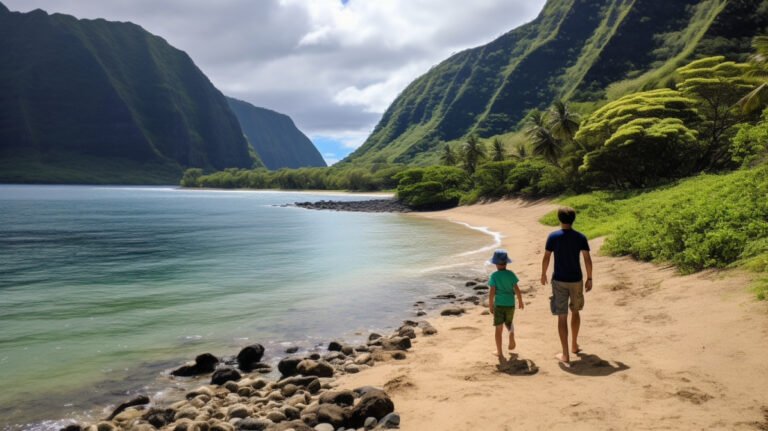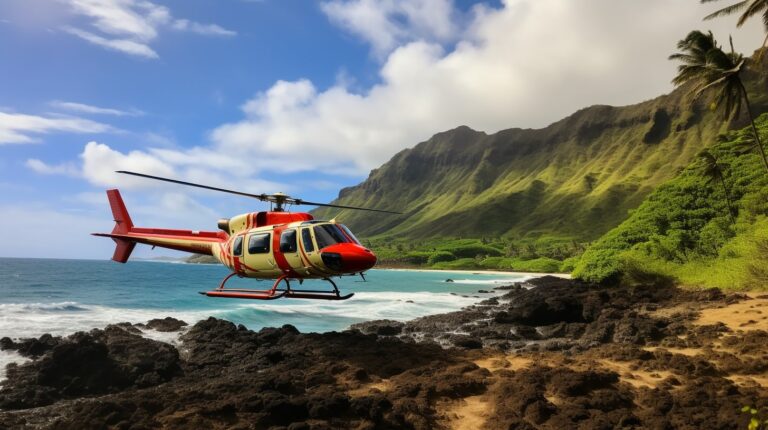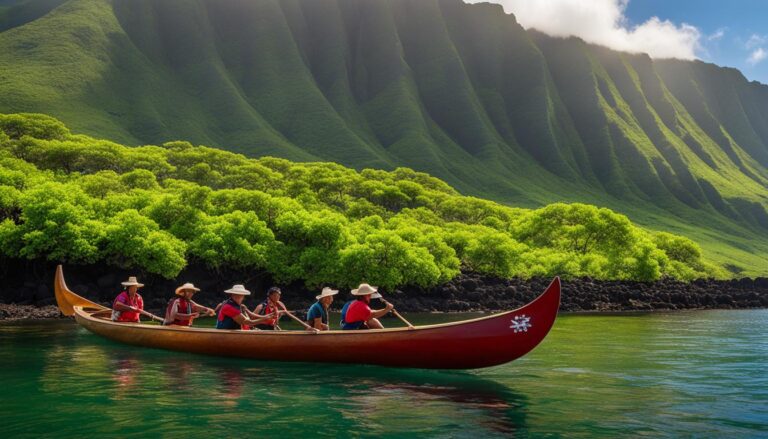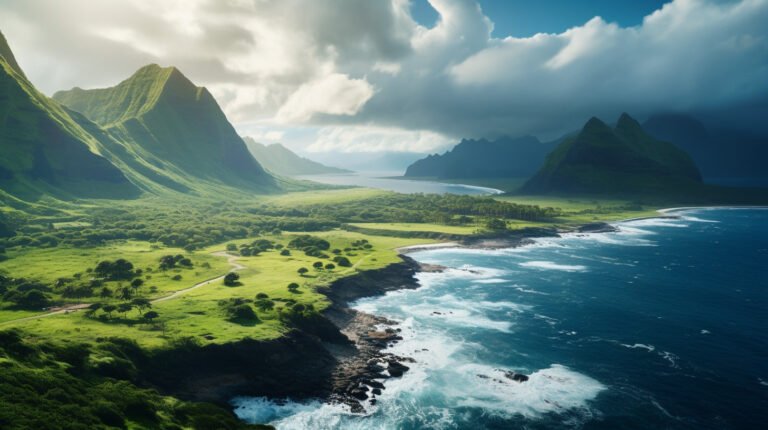🌴 Discover Sustainable Travel Secrets in Molokai 🌺
Traveling sustainably is essential to protecting the environment and preserving the cultural heritage of Molokai, one of Hawaii’s hidden gems. As an eco-conscious traveler, you can explore the beautiful island without leaving a negative impact on the environment.
Molokai offers a range of unique opportunities for sustainable travel, making it a premier destination for responsible tourism. Whether you prefer hiking through lush forests, snorkeling in protected marine areas, or learning about traditional practices, Molokai has something for everyone.
Key Takeaways:
- Sustainable travel is crucial to preserving Molokai’s natural beauty and cultural heritage.
- Molokai offers a variety of eco-friendly activities for travelers.
- Responsible tourism practices can minimize the ecological footprint and support local communities.
Why Choose Sustainable Travel in Molokai
When it comes to traveling, there’s an increasing awareness of the impact that one’s choices can have on the environment and local communities. Sustainable travel in Molokai offers a unique opportunity for eco-conscious travelers to minimize their ecological footprint and support the island’s cultural and environmental preservation efforts. Here are some reasons why you should choose sustainable travel in Molokai:
Minimizing Ecological Footprint
Sustainable travel in Molokai prioritizes responsible tourism practices that minimize the impact on the island’s delicate ecosystem. Choosing eco-friendly activities, accommodations, and transportation options can help reduce carbon emissions and waste. Responsible travelers can participate in community-based conservation projects and support sustainable agriculture, renewable energy initiatives, and wildlife protection efforts.
Supporting Local Communities
Traveling sustainably in Molokai allows you to directly support the island’s local communities. Supporting locally owned businesses, staying at eco-resorts, and buying locally made products help create jobs and boost the local economy. Engaging with the local community through cultural activities and events also fosters cultural exchange and understanding.
Experiencing Authentic Cultural Interactions
Molokai is home to a rich cultural heritage that is deeply intertwined with the environment. Embarking on a sustainable trip to Molokai can offer opportunities to participate in cultural workshops, learn about traditional practices, and support local artisans. Engaging with the local community in a responsible and respectful manner can create meaningful and authentic cultural interactions.
Eco-Friendly Activities in Molokai
Molokai is a nature lover’s paradise, with a plethora of eco-friendly activities to choose from. Whether you’re interested in hiking, birdwatching, or marine conservation, there are plenty of opportunities to explore the island’s unparalleled natural beauty.
One of the most popular activities on Molokai is hiking in the Halawa Valley. This lush valley is home to towering waterfalls, ancient archaeological sites, and a diverse array of flora and fauna. It’s a great way to get up close and personal with the island’s pristine wilderness and learn about the history and culture of the Hawaiian people.
| Activity | Location | Details |
|---|---|---|
| Hiking | Halawa Valley | Explore towering waterfalls, ancient archaeological sites, and a diverse array of flora and fauna. |
| Beachcombing | Papohaku Beach | Search for shells, sea glass, and other treasures on one of the longest and widest white sand beaches in Hawaii. |
| Snorkeling | Kamakou Preserve | Take a guided snorkeling tour in the protected marine area of the Kamakou Preserve, home to rare and endangered marine species. |
| Community-Based Conservation Projects | Kokua Kalihi Valley | Participate in community-based conservation projects, such as habitat restoration and native plant propagation, with Kokua Kalihi Valley. |
Another popular activity is exploring the island’s numerous beaches, such as Papohaku Beach, one of the longest and widest white sand beaches in Hawaii. Beachcombing, swimming, and surfing are some of the activities you can enjoy while admiring the island’s stunning coastline.
For those interested in marine conservation, taking a guided snorkeling tour in the protected marine area of the Kamakou Preserve is a must. This unique ecosystem is home to rare and endangered marine species and offers visitors a chance to learn about ocean conservation and marine science.
Finally, if you’re looking for a unique and meaningful experience, consider participating in community-based conservation projects with organizations like Kokua Kalihi Valley. These projects focus on habitat restoration, native plant propagation, and other conservation efforts that promote community engagement and environmental stewardship.
Sustainable Accommodation Options in Molokai
Choosing sustainable accommodation options for your stay in Molokai is a great way to support environmentally responsible tourism practices while experiencing the best of the island. Here are some of the top eco-friendly lodging options in Molokai:
| Accommodation Type | Description |
|---|---|
| Eco-Resorts | Eco-resorts in Molokai are designed to minimize environmental impact while offering guests a comfortable and luxurious stay. These resorts typically use renewable energy sources, practice sustainable waste management, and source local, organic food. |
| Vacation Rentals with Green Certifications | Many vacation rentals in Molokai have earned green certifications, which means they meet certain sustainability and environmental standards. Look for rentals that are LEED certified or part of the Green Hotels Association. |
| Locally Owned Bed and Breakfasts | Staying at a locally-owned bed and breakfast not only supports the local economy, but also gives you the opportunity to experience Molokai from a more authentic and personal perspective. Many of these B&Bs prioritize sustainable living practices, such as using solar energy and composting. |
Regardless of where you choose to stay, make sure to check if the accommodation has any eco-friendly policies in place and if they are committed to reducing their environmental impact through responsible tourism practices.
Responsible Dining in Molokai
One of the best ways to support sustainable practices in Molokai is through responsible dining. By choosing restaurants that prioritize local, organic ingredients, visitors can support the island’s farmers and minimize the ecological footprint of their meals.
The farm-to-table movement is strong in Molokai, with many restaurants using ingredients sourced directly from nearby farms and fisheries. One standout establishment is The Molokai Farmer’s Market and Deli, which offers a variety of fresh produce, baked goods, and homemade meals using locally grown ingredients. Kumu Farms is another great option, with a farm-to-table restaurant featuring fresh salads and sandwiches made with their own organic produce.
For a unique culinary experience, visitors can participate in the Kuahiwi Ranch Farm Tour and Dining experience, which includes a tour of the ranch’s sustainably managed pastures and a dinner featuring grass-fed beef and other locally sourced ingredients.
Responsible dining in Molokai also means being mindful of waste and supporting sustainable practices. Visitors can opt for reusable water bottles and utensils, and avoid single-use plastics and packaging whenever possible. By making conscious dining choices, visitors can enjoy delicious, authentic cuisine while supporting the island’s sustainable food practices.
Transportation Options for Sustainable Travel in Molokai
Choosing eco-friendly transportation options can significantly reduce your carbon footprint while exploring Molokai. Driving a rental car can have a negative impact on the environment, so consider alternative transportation methods.
Biking
Biking is one of the best ways to explore Molokai while minimizing your ecological impact. Molokai offers several scenic bike trails that take you through lush forests, coastal roads, and historic landmarks. You can rent a bike from several vendors on the island or bring your own.
Walking
Walking is another eco-friendly transportation option that allows you to take in the island’s natural beauty at a relaxed pace. Molokai has several walking trails that showcase the island’s diverse landscapes and cultural heritage. Make sure to wear comfortable shoes and bring sunscreen and water.
Public Transportation
Molokai’s public transportation system is an affordable and sustainable way to travel around the island. The Molokai Bus operates daily, offering several routes that cover most of the island’s popular tourist destinations. The bus operates on a fixed schedule, so make sure to plan your trip accordingly.
By choosing sustainable transportation options during your trip to Molokai, you can have a positive impact on the environment while experiencing all that the island has to offer.
Cultural Preservation and Community Engagement
One of the most crucial aspects of sustainable travel in Molokai is engaging with the local community and respecting the island’s cultural heritage. Molokai has a rich history and a unique culture, and it’s essential to support and preserve them.
Respecting Cultural Heritage
Molokai is home to many historical and cultural sites, including ancient fishponds, temples, and the Kalaupapa National Historical Park. When visiting these places, it’s important to be respectful of their significance and follow any cultural protocols.
Additionally, it’s important to recognize the value of traditional practices and knowledge held by the local community. Visitors can take part in cultural workshops, learn about traditional crafts and practices, and support local artisans.
Supporting Local Communities
By choosing sustainable travel in Molokai, you can also support the local economy and community. Consider staying in locally owned bed and breakfasts, eating at locally owned restaurants that use locally sourced ingredients, and buying souvenirs from local markets.
Visitors can also make a difference by participating in community-based conservation projects. These initiatives work to protect the environment, promote sustainable practices, and support the local community.
“Sustainable travel provides opportunities to experience the community in a meaningful way while leaving a positive impact,” says Hawaii Ecotourism Association Executive Director, Gail Grabowsky.
By engaging with the local community and respecting Molokai’s cultural heritage, travelers can gain a deeper understanding of the island and make a positive impact on their visit.
Sustainable Travel in Molokai: A Green Explorer’s Guide
Conservation Efforts in Molokai
Molokai is home to unique and fragile ecosystems that require conservation efforts to preserve their biodiversity. The Molokai Land Trust is a non-profit organization that works towards protecting and restoring the island’s natural areas. Their projects include removing invasive species, replanting native vegetation, and conserving endangered species.
The island also has marine conservation areas, such as the Moomomi Preserve, where visitors can snorkel and observe the vibrant marine life while supporting the preservation of these habitats.
| Conservation Initiative | Description |
|---|---|
| Maunaloa reforestation project | Aims to restore the native forests and prevent soil erosion in the Maunaloa area. |
| Kamakou Preserve | A protected natural area that is home to rare and endangered plant species. |
| Pu’u Ali’i bird sanctuary | Protects the habitat of endangered bird species such as the Hawaiian duck and Hawaiian coot. |
Travelers can support these conservation efforts by volunteering, donating, or participating in eco-tourism activities that promote sustainability and conservation.
“The conservation efforts in Molokai are crucial for the preservation of the island’s unique natural beauty and cultural heritage. By supporting these initiatives, travelers can make a positive impact on the environment and local communities.”
Tips for Being a Responsible Traveler in Molokai
As an eco-conscious traveler, it is important to be mindful of your impact on the environment and local communities. Here are some tips for being a responsible traveler in Molokai:
- Respect nature and wildlife: Stay on designated trails, avoid littering, and do not disturb wildlife.
- Minimize waste: Bring a refillable water bottle, pack reusable bags and containers, and dispose of trash properly.
- Support local businesses: Shop at locally owned stores and restaurants, and book tours and activities with locally operated companies.
- Learn about the local culture: Take time to understand and respect the customs and traditions of the local community.
- Be mindful of resources: Conserve water and electricity in accommodations, and choose eco-friendly transportation options.
By following these tips, you can help preserve the natural beauty and cultural heritage of Molokai while still enjoying a fulfilling and sustainable travel experience.
Responsible Souvenir Shopping in Molokai
When it comes to shopping for souvenirs in Molokai, it’s important to be mindful of the impact your purchases can have on the local environment and community. By opting for sustainable and locally made items, you can support the island’s economy and culture while also reducing your ecological footprint.
Here are some tips for responsible souvenir shopping in Molokai:
- Look for locally made products: Many of the souvenirs sold in Molokai are imported from other places, which can contribute to a larger carbon footprint. Look for items that are made on the island by local artisans, such as carved wooden bowls, handwoven baskets, or traditional Hawaiian quilts.
- Avoid items made from endangered species: Molokai is home to several endangered species, such as the Hawaiian monk seal and green sea turtle. Be sure to avoid purchasing items made from these animals, such as turtle shell jewelry or monk seal skin products, as it can contribute to their further decline.
- Support eco-friendly initiatives: Some shops in Molokai offer items that promote sustainability and eco-friendliness, such as reusable bags made from recycled materials or refillable bamboo straws. Consider these items as souvenirs that also help reduce waste and promote environmental awareness.
- Shop at local markets: Molokai has several weekly markets where local vendors sell handmade crafts, fresh produce, and other unique items. By shopping at these markets, you can support the local economy and get an authentic taste of Molokai culture.
Remember, responsible souvenir shopping not only supports the local community and environment but also ensures that authentic cultural heritage is preserved for future generations of travelers.
Planning Your Sustainable Trip to Molokai
Planning a sustainable trip to Molokai requires careful consideration of eco-friendly accommodations, activities, and transportation options. Here are some tips to help you plan your green adventure.
Best Time to Visit Molokai
Molokai has a year-round temperate climate, with average temperatures ranging from 70°F to 80°F. However, the best time to visit Molokai is during the drier months of April to October, when you can enjoy outdoor activities such as hiking and snorkeling without the risk of rain.
Eco-Friendly Accommodations
| Accommodation Type | Description |
|---|---|
| Eco-Resorts | These resorts are committed to sustainability and conservation. Many offer eco-friendly amenities, such as solar-powered energy and water conservation measures. |
| Vacation Rentals | Look for rentals that have green certifications, such as LEED or Energy Star. These rentals often have eco-friendly features like energy-efficient appliances and low-flow toilets. |
| Locally Owned Bed and Breakfasts | These B&Bs often have a more personal touch and support the local economy. They may also use sustainable practices such as composting and recycling. |
Recommended Itineraries
Here are some recommended itineraries for eco-conscious travelers:
- Explore the lush Halawa Valley on foot, followed by a farm-to-table lunch at a local restaurant.
- Snorkel in the protected waters of the Molokai Barrier Reef and learn about the ongoing conservation efforts.
- Volunteer with a community-based conservation project, such as building wetlands or planting native trees.
Transportation Options
Reduce your carbon footprint by using eco-friendly transportation options such as:
- Biking: Rent a bike or bring your own and explore the island on two wheels.
- Walking: Molokai has many walking trails where you can enjoy nature up close.
- Public Transportation: The Molokai bus system is an affordable and convenient way to get around the island.
Resources for Booking Sustainable Travel
Here are some resources to help you book sustainable travel in Molokai:
- The Molokai Visitors Association: This organization provides information on eco-friendly accommodations, activities, and transportation.
- The Hawaii Ecotourism Association: This association provides a list of eco-certified tour operators and accommodations in the state of Hawaii.
By following these tips, you can have a sustainable and enjoyable trip to Molokai while supporting the local community and protecting the environment.
Conclusion
In conclusion, traveling sustainably in Molokai benefits the environment, local communities, and cultural heritage preservation. Choosing eco-activities, green lodging and transportation enriches your experience while minimizing your footprint.
Prioritize conservation and cultural engagement as you explore. Consider the impact of your actions to help safeguard Molokai’s splendor. Follow responsible tourism practices to protect this island paradise.
Immerse yourself in an eco-friendly Molokai escape that sustains both the land and people. Download the Molokai Travel Guide Molokai Travel Guide to start planning your sustainable Molokai adventure. Help preserve this island jewel for tomorrow.
Make a Difference
We encourage you to take action and make a positive impact on your travel experiences by embracing sustainable practices. You can participate in conservation projects, engage with local communities, and support eco-friendly businesses. By doing so, you not only contribute to the preservation of Molokai’s natural and cultural resources but also inspire others to do the same.

